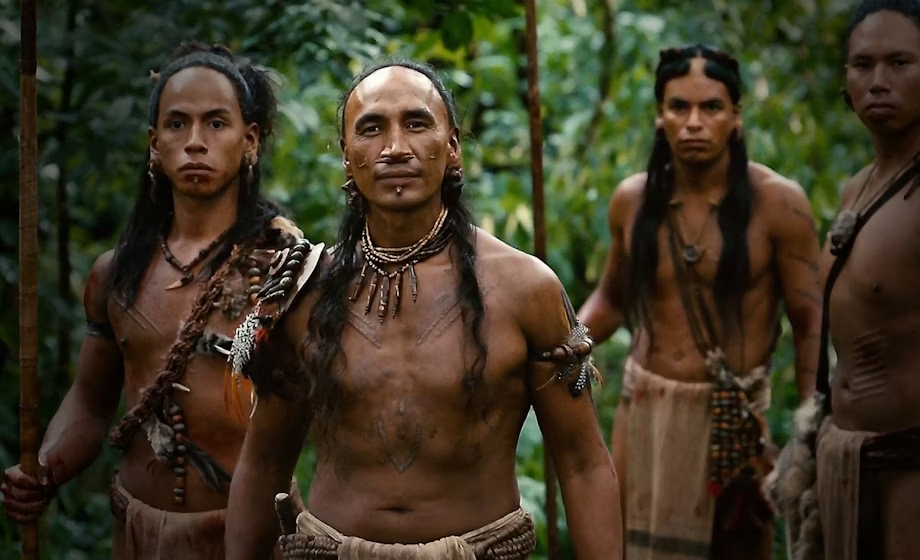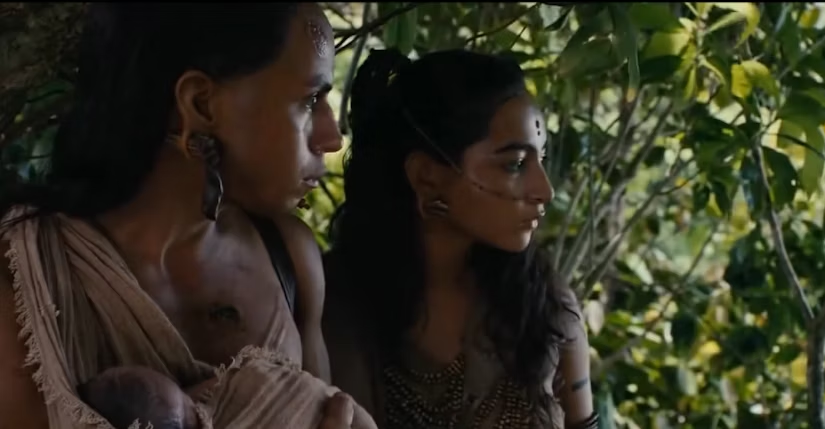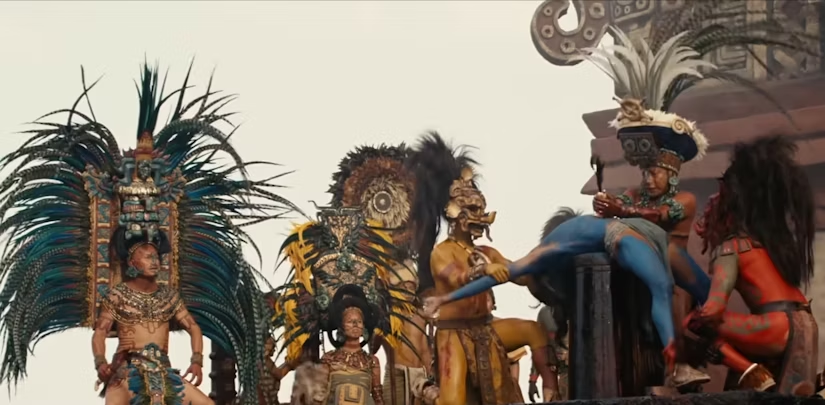In 2006, Mel Gibson released Apocalypto, a film set during the waning days of the Mayan civilization. At first glance, it’s an ambitious, action-packed thriller with stunning visuals and gripping storytelling. However, beneath the surface of this apocalyptic tale lies a darker subtext, one that is difficult to ignore in light of Gibson’s infamous personal controversies. The film’s depiction of the Mayan civilization has been criticized for historical inaccuracies and its portrayal of indigenous people, raising questions about Gibson’s intentions and underlying messages.
The Kiss of Death: “A Great Civilization Destroys Itself From Within”

Apocalypto opens with a foreboding quote: “A great civilization is not conquered from without until it has destroyed itself from within.” This sets the tone for the entire film, suggesting that the Mayan civilization’s collapse was the result of internal corruption, disease, and poverty. The movie’s narrative implies that the Mayan people were already on a path to self-destruction before any external force, such as the Spanish Conquistadors, could take them down.
One of the most memorable scenes features a young girl who prophesizes the fall of the Mayan world, warning the raiders that the end is near. This moment encapsulates the film’s central theme, but it also raises uncomfortable questions: Is the film suggesting that the Mayan people were to blame for their own downfall? This notion, when combined with the film’s historically questionable portrayal of the Mayans as bloodthirsty and savage, adds a disturbing layer to the movie’s message.
Mel Gibson’s Fall from Grace
Before we dive further into the film, it’s impossible to discuss Apocalypto without addressing the controversy surrounding Mel Gibson. Released before his public unraveling, Apocalypto would become the last film Gibson directed before the world saw his darker side. His anti-Semitic, racist, and misogynistic remarks made headlines soon after the film’s release, tainting his reputation in Hollywood.
Gibson’s outbursts have cast a long shadow over his body of work, particularly Apocalypto. Knowing what we do now about the director, it’s hard not to view the film through the lens of his personal prejudices. The harsh portrayal of the Mayan people as cruel and violent, while ignoring the rich cultural and intellectual achievements of the civilization, feels disturbingly aligned with Gibson’s problematic views.
The Plot: Jaguar Paw’s Fight for Survival
Set around 1502, Apocalypto follows Jaguar Paw, a tribesman from a peaceful hunting village deep in the jungle. His village is suddenly attacked by raiders from the Mayan city, leading to the brutal slaughter of many of his fellow villagers. The survivors are captured to be sold as slaves or used as human sacrifices in a savage ritual. Before being taken, Jaguar Paw manages to hide his pregnant wife and young son in a pit, vowing to return and save them.
What follows is an intense, high-stakes race against time as Jaguar Paw attempts to escape his captors and reunite with his family. The film’s action sequences are undeniably gripping, showcasing Gibson’s flair for tension and drama. The world-building is effective, and viewers quickly connect with Jaguar Paw and his plight. The film does an excellent job of making the audience care about the protagonist and his struggle for survival.
A Familiar Gibson Formula
Like many of Mel Gibson’s films, Apocalypto features relentless violence and a hero who seems almost superhuman in his abilities. Jaguar Paw is both the unluckiest and luckiest man in the entire jungle—constantly escaping death in impossible situations. It’s a narrative style reminiscent of Gibson’s previous works like Braveheart and The Patriot, where the protagonist is an everyman hero who manages to outsmart and overpower more ruthless enemies.

Buena Vista Pictures
However, one of Apocalypto’s strengths lies in its cast, comprised entirely of Native American and Indigenous Mexican actors. In an industry still grappling with diversity, this casting choice was a commendable step forward, especially in 2006. Additionally, the use of the Yucatec Mayan language adds an extra layer of authenticity to the film, immersing viewers in the world of the ancient civilization.
Historical Inaccuracies and Problematic Portrayal
Despite these positive aspects, Apocalypto takes considerable liberties with history. While it’s common for historical films to deviate from the truth for the sake of storytelling, Apocalypto’s portrayal of the Mayan civilization is not only inaccurate but also harmful.
The film heavily focuses on human sacrifice, a practice more commonly associated with the Aztecs rather than the Mayans. While the Mayans did practice human sacrifice, it was not on the grand scale depicted in the film. By emphasizing this brutal aspect of the culture and ignoring their achievements in fields like astronomy, mathematics, and architecture, Apocalypto presents a skewed and negative view of the Mayan people.
This portrayal becomes even more troubling when viewed in light of Gibson’s well-documented prejudices. Given his controversial statements about various racial and ethnic groups, the depiction of the Mayans as cruel and bloodthirsty savages feels far less like an artistic choice and more like a deliberate, racially charged portrayal.
A Not-So-Subtle Message

Buena Vista Pictures
At the end of the film, after Jaguar Paw has escaped his captors and reunited with his family, the final blow comes with the arrival of the Spanish Conquistadors. Their ships are seen in the distance, a clear indication that the Mayan civilization is about to face its ultimate downfall. The message is painfully obvious: the Mayans were already on the brink of collapse, and the Spanish arrival is simply the final nail in the coffin.
This conclusion feels unsettling, particularly given Gibson’s track record. It’s as if the film is suggesting that the Mayans were doomed by their own actions, long before any external force arrived. Such a message is problematic, especially when it comes from a filmmaker with Gibson’s history of inflammatory and prejudiced remarks.
A Well-Made Film with a Dark Undertone

Buena Vista Pictures
There’s no denying that Apocalypto is a well-crafted film. Its pacing, action sequences, and character development make it an engaging watch. It effectively tells a straightforward, high-stakes survival story, one that grips the audience from start to finish. However, the shadow of Gibson’s personal beliefs looms large over the film, making it difficult to separate the art from the artist.
The film’s problematic portrayal of the Mayan civilization and its historical inaccuracies raise legitimate concerns, especially when viewed in the context of Gibson’s past behavior. While Apocalypto remains a visually stunning and emotionally gripping film, it’s also a movie that leaves viewers questioning the motives behind its depiction of an ancient civilization.
Conclusion: A Flawed Masterpiece Tainted by Its Creator
Fifteen years later, Apocalypto still stands as a testament to Mel Gibson’s talent as a filmmaker. However, its portrayal of the Mayan people and its underlying messages are overshadowed by Gibson’s own controversies. As a cinematic work, it’s impressive. As a reflection of its creator’s worldview, it’s troubling. Ultimately, Apocalypto serves as both a powerful thriller and a reminder that the context in which a film is made can profoundly shape how we interpret its meaning.


